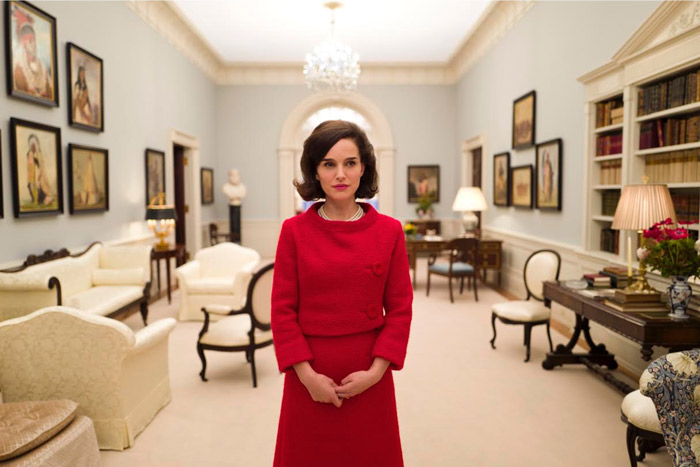Pablo Larrain’s Jackie is first and foremost concerned with history. This is not to say that the film’s objective is a mere chronological depiction of historical events. Rather, contrary to more conventional biopics, Jackie is concerned with the conscious role of individuals in creating history—which in the case of Jacqueline Kennedy Onassis, is a highly personal and ambitious enterprise.
Following Onassis after the assassination of her husband, President John F. Kennedy, Jackie offers an uncompromisingly intimate glimpse into an American tragedy and an icon left alone in the national spotlight. At times hard to follow, Larrain’s film weaves together a tapestry of memories from Jackie’s shattered psyche. It leaps chronologically from the former First Lady’s famous “Camelot” interview with Life Magazine in 1963 to her pacing feverishly through the White House in her bloodstained pink Chanel suit, to watching tearfully as Vice-President Lyndon B. Johnson is sworn in aboard Air Force One after departing Texas. Although the flashbacks often feel haphazard, the eclectic chronology is guided by phenomenal direction and performances—chiefly that of Natalie Portman in the titular role.
Portman’s Jackie Kennedy straddles a fine line between calculating and frantic throughout. With the First Lady’s Atlantic prep school purr mastered, she lives up to all the Oscar buzz her performance has earned. While her character does feel conspicuously practiced, as the film progresses we come to understand the careful attention to detail the First Lady invested in her public image: Jackie Kennedy’s character is inherently performative. As Portman navigates through Jackie’s grief, shock, fear, and pride, we watch her nervously struggle to keep her trademark poise intact. The narrative experience can be dizzying, but the film’s bold structuring is reflective of Jackie’s volatile grief, attempting to preserve the legacy of her White House’s “Camelot” myth, while coming to grips with the reality of her new situation.
Fittingly teeming with contradictions, Jackie’s story is framed by the aforementioned interview after the assassination of her husband. The conversation is tense, as journalist Theodore H. White (Billy Crudup) struggles to muster the necessary composure to move past the former First Lady’s guarded exterior. Her responses are sporadically candid and occasionally graphic as she describes her husband’s wounds. Watching Portman’s Jackie grapple with the way her story is told illustrates the film’s major themes of preserving one’s legacy and public image. However, the interview framing device often muddles her story’s progression, unnecessarily confusing the narrative. The late addition of a second, ambiguously dated post-assassination conversation with a priest (John Hurt) only adds to the chronological chaos.
The film’s frantic approach to its subject matter is tied together by Mica Levi’s (Under the Skin) mournful score, one of the year’s best. The discordant strings complement the film’s disorienting effect. It renders scenes—such as the one in which Jackie removes her iconic Chanel suit—all the more haunting.
Jackie possesses a near nightmarish quality that lingers upon exiting the theatre. Like no biopic before it, and likely none to come after it—barring Larrain’s imminent Neruda, that will explore the life of exiled Chilean poet Pablo Neruda—the film probes the dark underbelly of what it means to be a public icon. Larrain’s vision is singular; however, while the film strives for new ground, it often eschews clarity in the process.
Still, the ensuing chaos is beautifully ambivalent, befitting the enigmatic icon at its centre.








